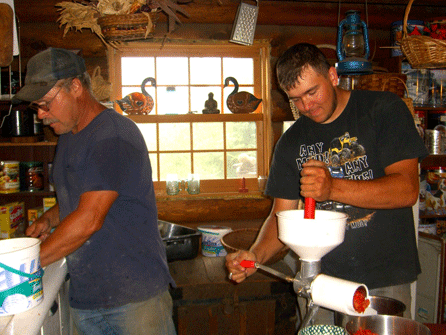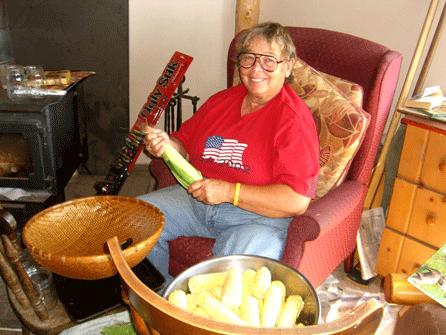Well, harvest is in full swing here. Luckily, all of your prayers are being answered for us, as Will and I continue to get better every day, although both of us are still plenty sore! The tomatoes and corn are doing very well, and we have buckets of tomatoes waiting on the porch. So David and Will volunteered to puree the second batch of 5 gallons of tomatoes. Will washes them in the sink, then pulls off stems and cuts them to go in the tomato strainer. David mans the crank, and out comes the tomato sauce!
This afternoon, I picked a basket of wonderful fat sweet corn while Will held the basket for me. (I still can’t bend over so hot.) Then I sat down in a recliner with two extra cushions behind my sore back and husked away. Out of this batch, I got 10 pints of corn, 5 pint jars, and 10 half-pints, which come in so handy for mixed recipes! No leftovers. With a small refrigerator, I love that!
When I get done blogging, we’ll have the tomato puree in the oven, in a big roasting pan, to gently cook down all night on very low heat. And in the morning, it’ll be ready…or about ready, to put in jars and process. Then we start all over again, with more corn, and more tomatoes! How neat!
AND the carrots are getting real big…so they’ll be next. Wow, we sure love harvest time!
Readers’ Questions:
Growing and canning pumpkins
I am growing pie pumpkins for the first time. Some questions:
1) How to tell when they are ripe?
2) I understand you bake them and then puree into pumpkin pie filling. Your book says not to can puree; to can chunks of pumpkin, instead. Do you bake it and then can the chunks? Your book calls for only heating the chunks and then processing. If I do it that way, do I need to do anything other than pureeing after the jar is opened?
Erica Kardelisk
Helper, Utah
Wait until the leaves have frosted and turned droopy black. Then pick your orange pumpkins and store them in a warm, frost-proof area for several weeks so they continue to mellow. If you use pumpkins too soon, they don’t develop the flavor they will after some storage time. To make a fresh pumpkin pie, you can bake and puree the pumpkin. We used to also do that to can the puree up. It was fast and easy. But now, experts don’t want us to do that, for safety’s sake, as the puree is a very thick, dense product, and it is possible that the center of the puree might not heat sufficiently to process safely, killing harmful bacteria, spores, and toxins possibly present in such a situation. So now we can up the raw chunks, then just open a jar, drain it out, puree the pumpkin chunks (which are now cooked and soft), and proceed with our recipes. — Jackie
Pole beans and using a wringer washer
Looks like your tomatoes went wild this summer. Can’t say the same for mine. My question is about pole beans. We used 3 poles and tied them together. That didn’t work and the first storm they all fell down. My husband then screwed them together and we pounded them into the ground several inches and that helped but now 4 of the 6 have fallen down again. Do you have a suggestion as to how to put up the poles to keep them from falling down? The bean plants have grown up to the top and are very heavy on the poles. Next year I may only grow bush beans as a result.
Thanks for all your advice. I have your canning book and it already has a couple stains on it from use. Hope you recover from your fall quickly. I noticed in your picture that you are using a wringer washer. My mother used one when I was growing up and one time got her arm caught in the wringer. Luckily her arm wasn’t hurt only bruised. What advantage do you find to using one of these machines over an automatic washer?
Ruth Ann Martin
Kalamazoo, Michigan
I use four or five poles for my pole beans, or else drive steel posts into the ground every 8′ or so and fasten either welded stock panels or woven field fencing to them, for the beans to climb on. Neither has ever blown down for me.
I’m glad my book has stains on it! Just yesterday, I was looking through one of Mom’s old cookbooks and saw stains on several of her favorite, much-used recipes. What memories that brought back for me!
I use a wringer washer for several reasons. First of all, it saves me a ton of water, literally! With less than 30 gallons, I can wash and rinse 5-6 loads…and they come cleaner than with an automatic washer. I can also wash dirty clothes longer than in an automatic, with no more fussing than just leaving them to agitate longer. Or take out cleaner, washed items while the rest continue agitating. Plus, that old Maytag brings back plenty of warm memories of Mom and Grandma’s old washers! — Jackie
Growing and preserving garlic
This is the first year I’ve ever grown garlic, and I have a question. The stalks of plant seemed to die back way too early, and so since the stalks were gone now, I dug it yesterday. When I dug them up, I was surprised to find a bunch of loose cloves of garlic, without skins. Like, already peeled garlic. They aren’t in heads (although there were a few heads of garlic, most were loose, skinless cloves). So, I got quite a bit of these loose cloves, probably enough to last me half a year, but, how do I keep them?
Angela Billings
Stronghurst, Illinois
Your two best bets are to slice and dehydrate your skinless cloves or else freeze them in small batches. If you elect to freeze them, lay them in a single layer on a cookie sheet to pre-freeze them. Then package them in freezer containers. That way, they won’t clump together and when you want to use only a clove or two, you have them right there, easy to use. Dehydrated garlic is great! I slice the cloves in half (unless they’re very large), then dry them. After they’re dehydrated, I often whiz them in the blender to make coarse garlic powder. It’s amazing at how many uses I find for it!
Garlic does best planted in the fall, so you might want to plant a row or bed soon, for harvest next year. You’ll find that you’ll have more heads of garlic, not loose cloves. — Jackie





Hi Jackie,
Wondering about how many ears of corn you harvested for the 10 jars.
There’s a local farmer nearby, that I’d like to buy some corn from, but not sure how much to buy, given that it’ll be my first time canning it.
TIA,
Donna G.
I get my certified organic garlic bulbs from The Garlic Store in Ft. Collins, Colorado. Their web site has a lot of growing and harvesting information. Garlic should be dug when most of the bottom of the stalk turns brown, and that can happen in summer. Bulbs left in the ground after the stalk has turned brown can shatter – and mine have. If you were growing a small size garlic, that may be why you saw all those little cloves. Those little cloves can be used to flavor cooking oil or planted in spring or fall. They will produce a plant that looks like green onions, and can be pulled or cut and used as a green onion would be in cooking or salads.
Another option for keeping garlic is to preserve it in brine. I use six tablespoons of sea salt to half a gallon of filtered water (the chlorine in tap water makes it unsuitable for this use) and pour the brine into quart jars filled with peeled cloves. Let them sit loosely covered for several days, keep the garlic submerged with a small jar, and they’ll bubble up with a white foam. When the bubbling settles down, put lids on the jars. I keep the jars in the fridge, but have read that under cool conditions such as a root cellar they are said to last many months. I don’t have cool conditions this time of year! So in the fridge they go. The garlic mellows nicely in the jars, really delicious.
Comments are closed.